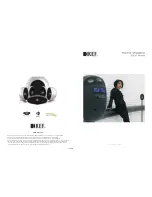
2
Digital Radio is like analogue FM radio but even better. Digital radio offers an abundance of new digital only stations, improved sound quality, no frequencies
to remember as stations are displayed using names, which makes it very easy to tune. The audio quality of DAB is near that of a CD with no interference and
no retuning, and the introduction of text, data and even pictures will enhance DAB in the future .
The BBC was the pioneer of digital radio, beginning transmissions in September 1995. Digital One, the national commercial radio multiplex operator began
broadcasting in November 1999. There has been a growth in the number of digital radio stations throughout the UK and both the BBC and Digital One are
committed to extending their coverage. Digital One currently covers 80% of the UK population, soon to increase to 85%, and the BBC covers 65% with the aim
of increasing coverage to 80% by 2003.
To find out about digital radio coverage in the UK, check out the following websites:
BBC:
www.bbc.co.uk/digitalradio
National Commercial Radio: www.ukdigitalradio.com
DRDB:
www.drdb.org
Your Acoustic Solutions SP110 DAB tuner will receive programs broadcast on Band 3 digital radio (174-240MHz), there are 41 channels within this range
numbered 5A to 13F, the number of channels you can receive will be dependant on your location and signal strength. The UK has been allocated seven
multiplexes by the Radio Authority - in the spectrum 217.5-230.0 MHz, which are numbered 11B to 12D.
A multiplex is a broadcaster such as BBC or Digital One who will provide a host of different stations within their multiplex. If we consider the BBC as an
example, the following diagram shows how the BBC multiplex may work.
The multiplex name is BBC (also sometimes referred to as an ensemble)
Also shown is channel and carrier frequency although it is not
necessary to know this as the BBC is known by name rather than
frequency.
Below the main multiplex provider name will be a host of primary stations.
These are labelled as the station name again rather than the frequency.
This allows you to tune SP110 by station name, which is easier than
trying to recall frequencies.
Sometimes a secondary service station may be provided by the
broadcaster, for instance this is sometimes used when an
alternative commentary is provided on a sporting match or event.
These secondary service stations are not permanent and may not
always be used for broadcast. When a secondary station is available
below the primary station, the following symbol will be shown
on the display of the SP110; >>.
Details on how to use the SP110 are covered in the following pages.
Summary of Contents for SP110
Page 18: ...REV 1 026 1 0 ...



































